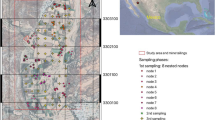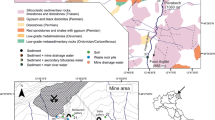Abstract
The Cu–Co–Ni Texeo mine has been the most important source of Cu in NW Spain since Roman times and now, approximately 40,000 m3 of wastes from mine and metallurgical operations, containing average concentrations of 9,263 mg kg−1 Cu, 1,100 mg kg−1 As, 549 mg kg−1 Co, and 840 mg kg−1 Ni, remain on-site. Since the cessation of the activity, the abandoned works, facilities and waste piles have been posing a threat to the environment, derived from the release of toxic elements. In order to assess the potential environmental pollution caused by the mining operations, a sequential sampling strategy was undertaken in wastes, soil, surface and groundwater, and sediments. First, screening field tools were used to identify hotspots, before defining formal sampling strategies; so, in the areas where anomalies were detected in a first sampling stage, a second detailed sampling campaign was undertaken. Metal concentrations in the soils are highly above the local background, reaching up to 9,921 mg kg−1 Cu, 1,373 mg kg−1 As, 685 mg kg−1 Co, and 1,040 mg kg−1 Ni, among others. Copper concentrations downstream of the mine works reach values up to 1,869 μg l−1 and 240 mg kg−1 in surface water and stream sediments, respectively. Computer-based risk assessment for the site gives a carcinogenic risk associated with the presence of As in surface waters and soils, and a health risk for long exposures; so, trigger levels of these elements are high enough to warrant further investigation.




Similar content being viewed by others
References
Allan R (1997) Introduction: mining and metals in the environment. J Geochem Explor 58:95–100
Alloway BJ (1995) Heavy metals in soils, 2nd edn. Chapman & Hall, London, p 368
Álvarez-Würtenberger A (2000) Estudio de la contaminación por metales pesados en suelos y aguas del área de influencia de la antigua explotación minera de cobre Mina Texeo (Asturias). Proyecto Fin Carrera, University of Oviedo, Unpublished, 168 p
Anderson MA, Bertsch PM, Feldman SB, Zelazny LW (1991) Interactions of acidic, metal-rich coal pile runoff with a subsoil. Environ Sci Technol 25:2038–2046
Arias E, Loredo J, Ordóñez A, García-Iglesias J (1998) Mercury and arsenic content of soils and plants in the area of an abandoned mercury mine at El Terronal (Mieres, Spain). In: Sarsby RW (ed) Contaminated and derelict land vol 1. Thomas Telford, pp 162–165
Ashley PM, Lottermoser BG, Chubb AJ (2003) Environmental geochemistry of the Mt. Perry copper mines area, SE Queensland, Australia. Geochem Explor Environ Anal 3:345–357
Blowes DW, Jambor JL (1990) The pore-water geochemistry and the mineralogy of the vadose zone of sulfide tailings. Waite Amulet, Quebec, Canada. Appl Geochem 5:327–346
Bolviken B, Nilsen R, Ukkelberg A (1997) A new method for spatially moving correlation analysis in geomedicine. Environ Geochem Health 19:143–153
Bowen HJM (1979) Environmental chemistry of the elements. Academic, London
Connor JA, Bowers RL, Nevin JP, Fisher RT (1998) Guidance manual for RBCA tool kit for chemical releases. Groundwater Services
Das D, Samanta G, Mandal BK, Chowdhury TR, Chanda CR, Chowdhury PP, Basu GK, Chakraborti D (1996) Arsenic in groundwater in six districts of West Bengal, India. Environ Geochem Health 18:5–15
Davies BE (1983) Heavy metal contamination from base metal mining and smelting: implications from man and his environment. In: Thornton I (ed) Applied environmental geochemistry. Academic, London, pp 425–462
Davies BE, Wixson SG (1987) Use factor analysis to differentiate pollutants from other trace metals in surface soils of the mineralised area of Madison County, Missouri, USA. Water Air Soil Pollut 33:339–348
Dory A (1893) Las antiguas minas de cobre y cobalto del Aramo, descubiertas por el Ingeniero Sr. Van Straalen. Rev Minera Metalúrgica y de Ingeniería Madrid XLIV 1463:333–362, 1466:861–866
Einax JW, Soldt U (1998) Geostatistical and multivariate statistical methods for the assessment of polluted soils -merits and limitations. Chemom Intell Lab Syst 46:79–91
Fanlo I, Subías I, Gervilla F, Paniagua A, García B (2004) The composition of Co–Ni–Fe. Sulfarsenides, diarsenides and triarsenides from the San Juan de Plan deposit, Central Pyrenees, Spain. Can Mineral 42:1221–1240
Francis BM (1994) Toxic substances in the environment. Willey Inter Science, 360 p
Gallego JLR, Loredo J, Ordóñez A (2002) Investigation of trace elements sources from an industrialized area (Avilés, Northern Spain) with multivariate statistical methods. Environ Int 27:589–596
Gómez-Landeta F, Solans J (1981) Procesos supergénicos en la mina de cobre del Aramo, Asturias. Boletín Geológico Minero Madrid 92:429–436
Gutiérrez-Claverol M, Luque C (1993) Recursos del subsuelo de Asturias. Universidad de Oviedo, 392 p
Hem RS, Makovicky E (2004) The system Fe–Co–Ni–As–S. I phase relations in the (Fe, Co, Ni) As0.5S1.5 section at 650° and 500°C. Can Mineral 42:43–62
Hevia T (1959) Las minas metálicas de Asturias. Real Instituto de Estudios Asturianos, Oviedo
Julivert M (1971) Decollement tectonics in the hercynian Cordillera of Northwest Spain. Am J Sci 270:1–29
Kabata-Pendias A, Pendias H (1984) Trace elements in soils and plants. CRC, Boca Raton, p 315
Kelley KD, Kelley DL (2003) Metal dispersion and mobility in soils from the Lik Zn–Pb–Ag massive sulphide deposit, NW Alaska: environmental and exploration implications. Geochem Explor Environ Anal 3:179–195
Loredo J (2000) Historic unreclaimed mercury mines in Asturias (Northwestern Spain): Environmental approaches. In: US Environmental Protection Agency, assessing and managing mercury from historic and current mining activities, San Francisco, 175–180
Loredo J, Ordóñez A, Rodríguez JL, Baldo C, García-Iglesias J (1999) Geochemical characterisation of mercury mining spoil heaps in the area of Mieres (Asturias, northern Spain). J Geochem Explor 67(1–3):377–390
Loredo J, Alvarez R, Ordóñez A (2003) The role of portable analytical technologies in soils environmental prospecting. Memórias e Noticias Portugal 2(Nova Série):331–341
Luque C, Martínez-García E (1983) Depósitos minerales en el Carbonífero de la Cordillera Cantábrica. Paper presented at the 10th Congreso Internacional de Estratigrafía y Geología del Carbonífero, Madrid, 3:95–104
McMartin I, Henderson PJ, Nielsen E (1999) Impact of base metal smelter on the geochemistry of soils of the Flin Flon region, Manitoba and Saskatchewan. Can J Earth Sci 36:141–160
Oriol R (1893) Criaderos de cobalto del Aramo. Revista Minera, XI, 390 p
Paniagua A, Loredo J, García-Iglesias J (1987) Epithermal mineralization in the Aramo mine (Cantabrian Mountains, NW Spain): correlation between paragenesis and fluid inclusions data. Bull Mineral (Paris) 111:383–391
Piispanen R (1989) Geochemical interpretation of cancer maps of Finland. Environ Geochem Health 11:145–147
Plumlee GS (1999) The environmental geology of mineral deposits. In: Plumlee GS, Logsdon MJ (ed) The environmental geochemistry of mineral deposits. Part A: processes, techniques and health issues. Reviews in economic geology, 6A, Society of Economic Geologists, Littleton, pp 71–116
Ritchie AIM (2003) Oxidation and gas transport in piles of sulphidic material. In: Jambor JL, Blowes DW (eds). Mineralogical Association of Canada, Chap 8: short course, 31:201–245
Salomons W (1995) Environmental impact of metals derived form mining activities: processes, prediction, prevention. J Geochem Explor 52:5–23
US-EPA (1989) Risk assessment guidance for superfund, 1, human health evaluation manual (Part A), EPA/540/1-89/002. US Environmental Protection Agency, Washington DC, p 289
US-EPA (1993) Landscape-scale effects of toxic events for ecological risk assessment. EPA/630/R-93/3. Environmental Research Laboratory. US Environmental Protection Agency, Corvalis, p 24
Vinogradov AP (1959) The geochemistry of rare and dispersed chemical elements in soils. Consultants. Bureau, New York
Warren HV (1989) Geology, trace elements and health. Soc Sci Med 8:923–926
Wels C, Lefebvre R, Robertson AM (2003) An overview of prediction and control of air flow in acid-generating waste rock dumps. In: Farrell T, Taylor G (eds) Paper presented at the 6th international congress on acid rock drainage, Australasian Institute of Mining and Metallurgy, Cairns, publishing series 3/2003:639–650
Yong RN, Mohamed AMO, Warkentin BP (1992) Principles of contaminant transport in soils: developments in geotechnical engineering. Elsevier, Amsterdam, 73, 327 p
Author information
Authors and Affiliations
Corresponding author
Rights and permissions
About this article
Cite this article
Loredo, J., Álvarez, R., Ordóñez, A. et al. Mineralogy and geochemistry of the Texeo Cu–Co mine site (NW Spain): screening tools for environmental assessment. Environ Geol 55, 1299–1310 (2008). https://doi.org/10.1007/s00254-007-1078-y
Received:
Accepted:
Published:
Issue Date:
DOI: https://doi.org/10.1007/s00254-007-1078-y




